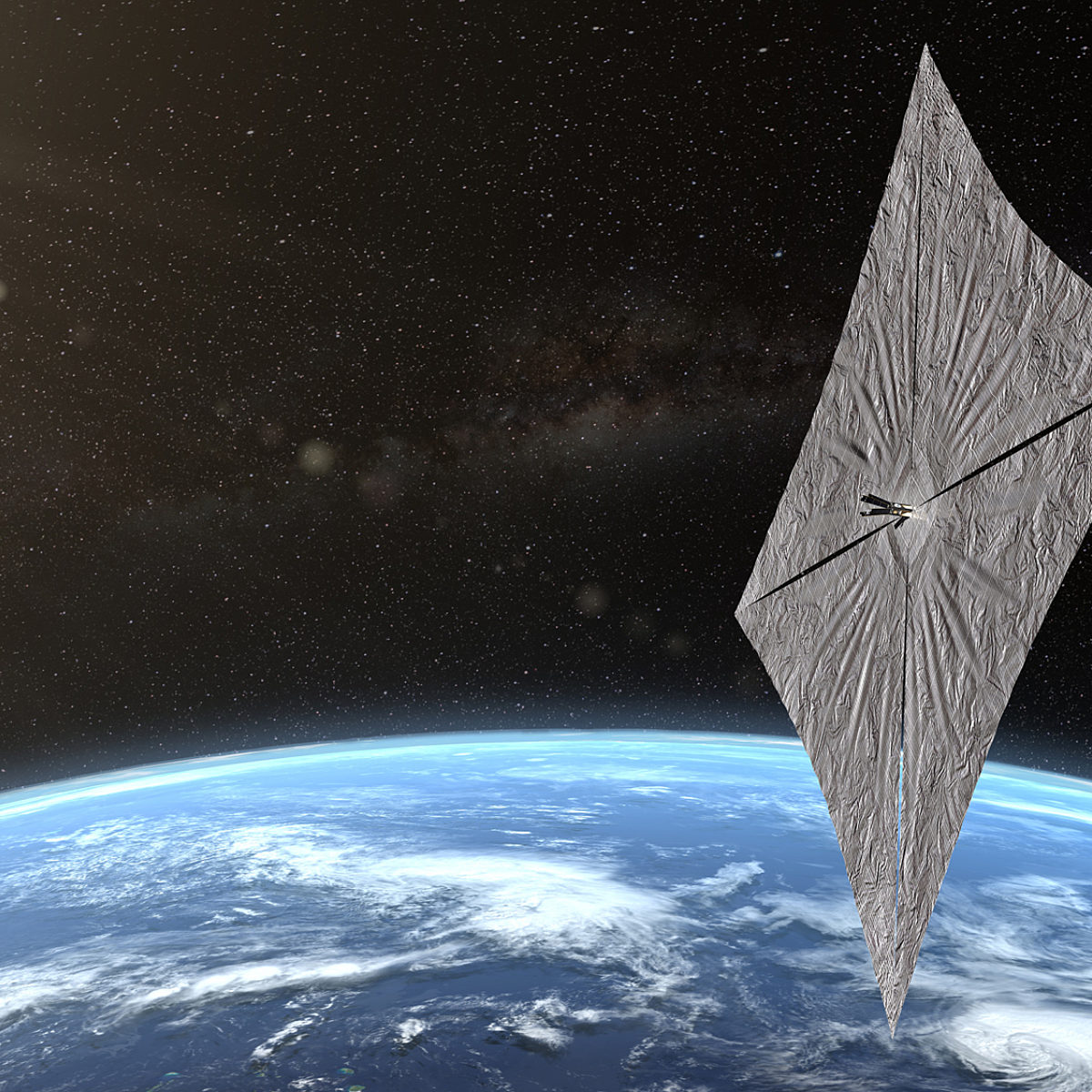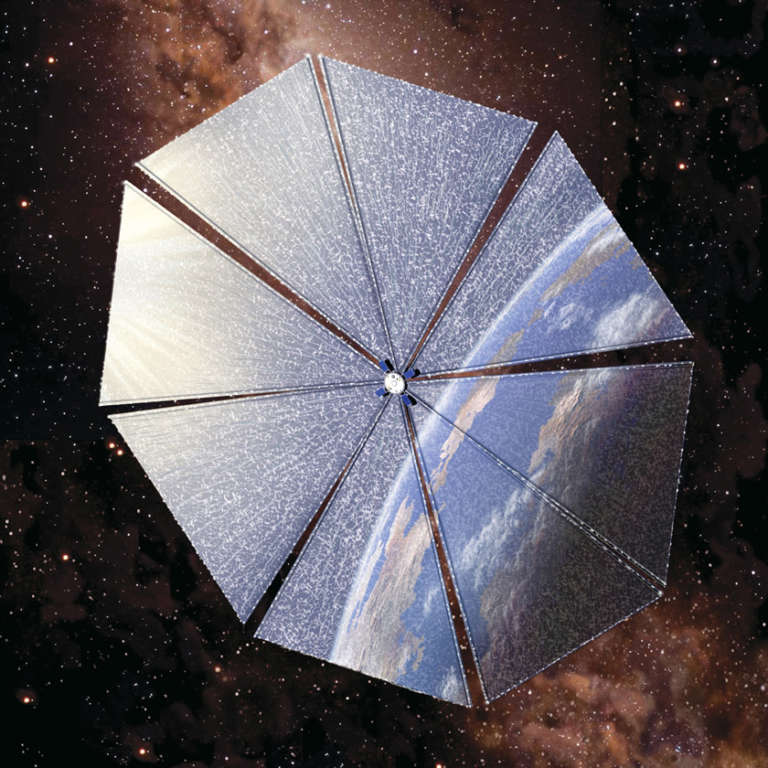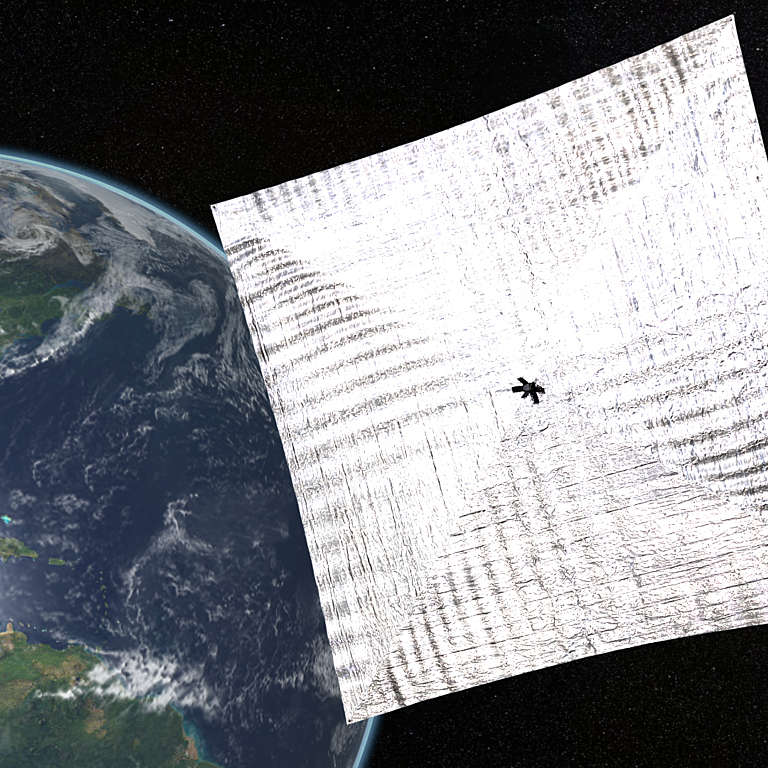The Story of LightSail, Part 1
In 1607, a comet appeared in the skies over Europe.
No one knew it was the same comet that had shown up in 1531, or that it would return again in 1682. Astronomer Edmond Halley would eventually figure out the comet’s 75-year orbital period, and predict its 1759 reappearance. But in 1607, it was just a plain old comet—an astronomical curiosity exciting a populace in the midst of a scientific and technological renaissance.
Among the comet watchers was 36-year-old German astronomer Johannes Kepler, who watched the apparition with great interest. Kepler wondered what caused the comet’s broad tail to spread into a wide swath that arced gently across the sky. Sunlight, he thought, must be heating the comet and liberating material from its surface.
Though Kepler had no way to prove his hypothesis, it was a profound—and ultimately correct—observation. Ice and dust streaming off of a comet form a temporary atmosphere called a coma. Sunlight itself pushes on dust particles in the coma, scattering them in all directions. Some escape the comet’s gravitational hold, creating a tail that extends off the comet.
The notion of the sun’s rays interacting with a celestial object led Kepler to believe that a space sail might one day capture sunlight the way a boat sail catches the wind. In a 1608 letter to Galileo Galilei, Kepler wrote that the humans might one day use the technology to set a course for the stars:
“Provide ships or sails adapted to the heavenly breezes, and there will be some who will brave even that void.”
— Johannes Kepler
Kepler's idea would not find academic footing until 1865, when James Clerk Maxwell demonstrated light was made of packets of energy called photons. Photons, Maxwell showed, have energy and momentum that can be transferred to other objects. When photons strike a reflective surface like a shiny solar sail, they push the sail forward. In the early twentieth century, a pair of Russian scientists combined Maxwell's work with actual engineering concepts. “For flight in interplanetary space I am working on the idea of flying, using tremendous mirrors of very thin sheets, capable of achieving favorable results,” wrote engineer Fridrikh Tsander in 1924.
What is solar sailing?
A solar sail, simply put, is a spacecraft propelled by sunlight. Whereas conventional rockets are propelled by the combustion of rocket fuel, a solar sail is pushed forward by light from the Sun.
Swift advances in rocketry during World War II placed humanity on the brink of the space age, and the idea of solar sailing surfaced again—this time, in a science fiction magazine. In the May 1951 issue of Astounding Science Fiction, electrical engineer Carl Wiley proposed a parachute-like solar sail, opened towards the sun. The parachute would use tethers to tow a spacecraft behind it.
Wiley’s sail concept had a radius of 4 kilometers, and an area of 61 square kilometers. “The ship,” he wrote, “must be docked at an artificial satellite circling the planet, and passengers and freight ferried to and from the planet by rocket. The ship itself must be built at the artificial satellite.” The idea was so far out, Wiley published the article under the pseudonym Russell Saunders—a reference to a quantum physics concept called Russell-Saunders Coupling.

In 1957, the launch of Sputnik moved space satellites off the drawing board and into reality. Just a year later, solar sails started appearing in the scientific literature. By the 1960s, the newly formed National Aeronautics and Space Administration found itself flush with cash, as it raced to fulfill President John F. Kennedy's goal of landing humans on the moon by the end of the decade. The space agency subsequently funded a variety of solar sail studies. But in the post-Apollo 1970s, NASA’s funding receded, and solar sailing research was shelved.
At the Battelle Memorial Institute in Ohio, a lone engineer named Jerome Wright pressed on, determined to prove the viability of solar sailing. NASA had originally asked Wright to examine what kind of rocket system could launch a solar sail into space. Wright took the analysis a step further, and began running the numbers on potential solar sail missions to other planets.
In the process, Wright discovered a once-in-a-lifetime opportunity: a trajectory that could send a solar sail to rendezvous with Halley's Comet, which was scheduled to return in 1986. The same comet that set solar sailing in motion back in 1607 could become the technology's first destination.
You can increase discoveries in the worlds of our solar system and beyond. When you join The Planetary Society, you help build public support for planetary science, encourage decision makers to prioritize human and robotic exploration, and support technological advances in planetary exploration.
Become A MemberLouis Friedman didn’t know much about solar sailing when he heard about Jerome Wright's idea. A kid from the Bronx turned scientist-engineer, Friedman had earned a master's degree in engineering mechanics from Cornell University, and a Ph.D. in aeronautics and astronautics from MIT. In 1970, his career led him to NASA's Jet Propulsion Laboratory in Pasadena, California, where he worked on deep space missions like Mariner and Voyager. He also headed up JPL’s Advanced Projects Group, which was responsible for developing new mission ideas.
Friedman already knew sunlight pressure pushed things around in space. He examined the phenomenon in his Ph.D. thesis, which modeled how non-gravitational forces affected spacecraft. In 1960 and 1964, NASA launched two, large, Mylar-coated balloons into orbit to test how communications signals could be bounced across the country. Because the balloons were big and light, they were easily moved by sunlight.
Mariner 4, the first probe to fly past Mars and return images, was equipped with four solar vanes that used sunlight pressure to stabilize the spacecraft. Engineers used the sun to their advantage again during the Mariner 10 mission to Venus and Mercury, after Mariner ran out of attitude control gas. Flight controllers oriented the spacecraft's reflective solar panels in a way that caused sunlight to spin the vehicle, stabilizing it.

In Friedman's book, Starsailing: Solar Sails and Interstellar Travel, he recalled a discussion he had with a fellow JPL engineer upon hearing about Wright's idea to send a solar sail to rendezvous with Halley's Comet:
“You mean fly-by, not rendezvous,” I said.
“No, I mean rendezvous.”
“With a trip time of ten years?”
“Would you believe four years?”
Spacecraft have two options when it comes to visiting another planetary body. They can fly past their target, capturing as much data as possible. Or, they can bring lots of fuel, fire their engines and slow down for a rendezvous. A rendezvous with Halley’s Comet seemed impossible. Earth circles the sun counterclockwise at about 30 kilometers per second. Halley, on the other hand, enters the inner solar system clockwise, from beneath our orbital plane. As it nears the sun, Halley picks up a lot of speed, racing past Earth at 40 kilometers per second.
This means a spacecraft trying to rendezvous with the comet has a lot of work to do. It must cancel out the Earth's 30 kilometers per second speed, pick up 40 in the other direction, and tilt the plane of its orbit.
One way to do this is with a really powerful rocket—and in fact, this idea was on the table. Engineers proposed boosting a spacecraft out to Jupiter with a mammoth Saturn V moon rocket, where the spacecraft would slingshot around the giant planet, and kick itself into a reverse orbit that matched Halley's Comet. A better method, Jerome Wright believed, was a solar sail.
Unlike chemical rockets that provide short, powerful bursts of acceleration, solar sails accelerate slowly but continuously—and can ultimately reach much higher speeds. Depending on the way the sail is angled, the force from sunlight can either decrease or increase a spacecraft's orbital velocity. The Halley sail would first decrease its speed, spiraling inward towards the sun. There, the sun’s energy would transfer enormous amounts of momentum to the sail, sending it outward into a different orbit.
NASA was interested in the idea. The space agency funded a preliminary Halley sail study, and in 1975, Wright joined Friedman and other engineers at JPL to work on the idea. The team considered two designs. The first was a square, kite-like sail measuring a half-mile per side. Four booms on the backside formed the sail’s structure. Each boom had a small solar vane at the end, which could be angled to provide attitude control by a spacecraft at the center. The design was simple and elegant, but the team was worried the sail lacked rigidity, and might wobble around in a way that couldn’t be modeled or controlled.
The second design was called the heliogyro, and resembled two ceiling fans stacked on top of one another. Each fan had six blades, and would spin, giving the sails greater stability. But because the heliogyro still needed the same surface area as the square sail, each blade would have to be more than four miles long. Nevertheless, the heliogyro design was chosen—a decision Friedman would later regret on both aesthetic and technical grounds.
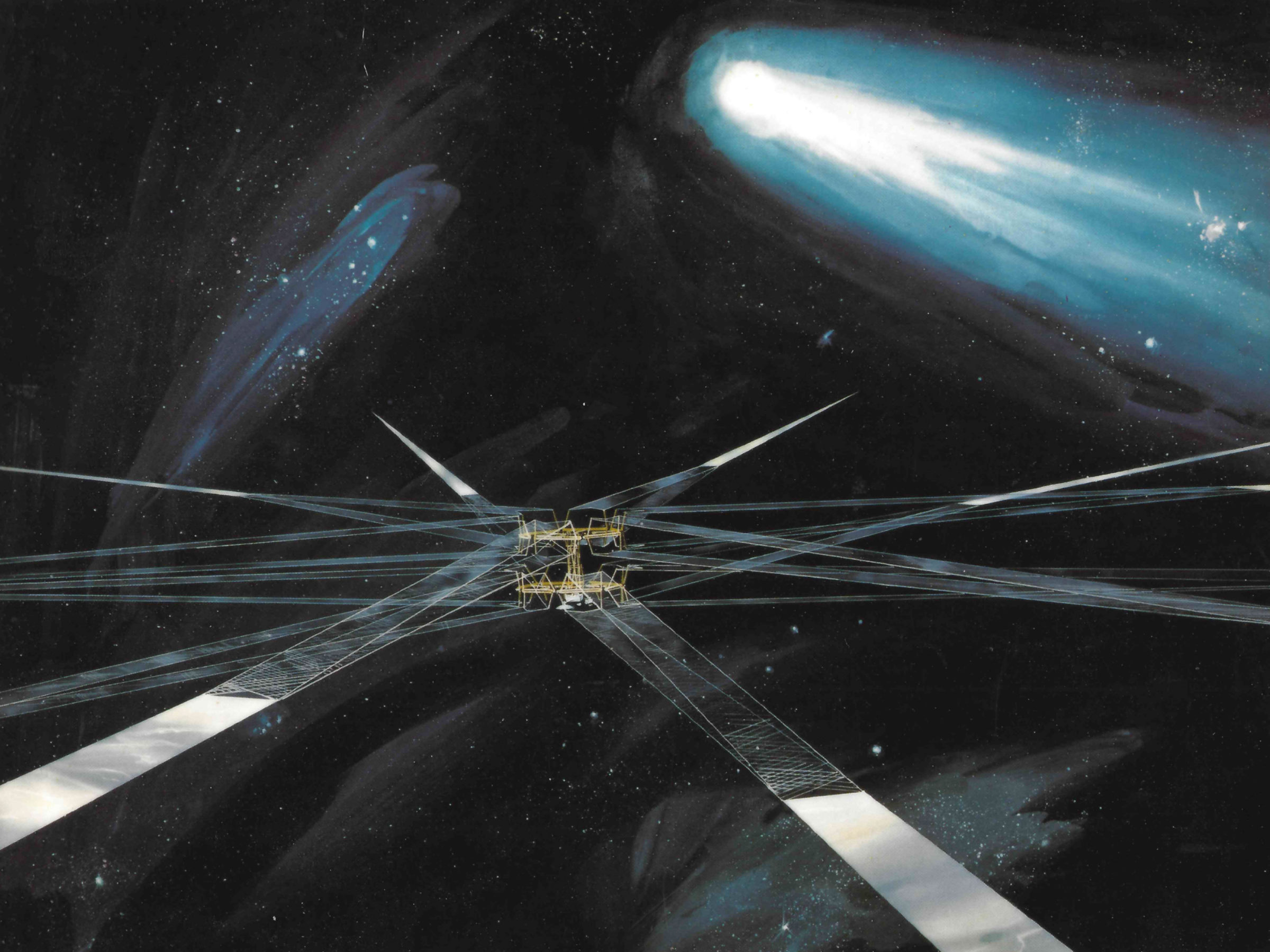
The challenge of packaging and deploying such a large structure in space was daunting—until the space shuttle was approved for construction in 1973. “That was a large payload volume, and from the payload bay, you could deploy things into space,” Friedman said. “That began to get people thinking about practical designs for the deployment of large space structures.” Could astronauts aboard the yet-to-be-built shuttle transport the sail to Earth orbit, and deploy it from the payload bay? Possibly.
But while the shuttle offered new ways to launch payloads, its price tag was gobbling up an increasingly large share of NASA's budget. The 1970s had been a golden age for planetary exploration, with missions like Pioneer, Viking and Voyager returning a waterfall of images and data. However, from 1978 to 1990, no new planetary missions were approved by Congress and the White House.
Dr. Bruce Murray, the director of NASA’s Jet Propulsion Laboratory, was adamant that a mission to Halley’s Comet was scientifically valuable. It would also, he argued, capture public enthusiasm for planetary exploration. By 1978, the Halley sail had passed its preliminary design studies, and Murray was supporting the project. But the clock was ticking. The mission needed to launch by 1982 for the spacecraft to have enough time to make its date with Halley. And before that could happen, sail assembly techniques needed to be practiced aboard an actual space shuttle flight.
At the same time, NASA was experimenting with ion propulsion drives, which use electricity to strip electrons off a gas like xenon, creating ions. The ions are then accelerated out of the spacecraft, creating low-thrust, continuous propulsion. The technology was promising, and it was backed with more than a decade of development and testing by the aerospace industry. And like the solar sail, an ion drive spacecraft would be launched from the shuttle’s payload bay.
Although ion propulsion would eventually go on to power several planetary exploration missions, the technology wasn’t ready in time for a mission to Halley’s Comet. Neither was the heliogryro, said Friedman, recalling that the concept was ultimately too ambitious. And even if the heliogyro or ion drive had been ready to fly, the space shuttle wasn’t. Its first flight was delayed until 1981, with operational missions finally starting in 1982—too late to properly test and launch a long-duration mission to Halley.
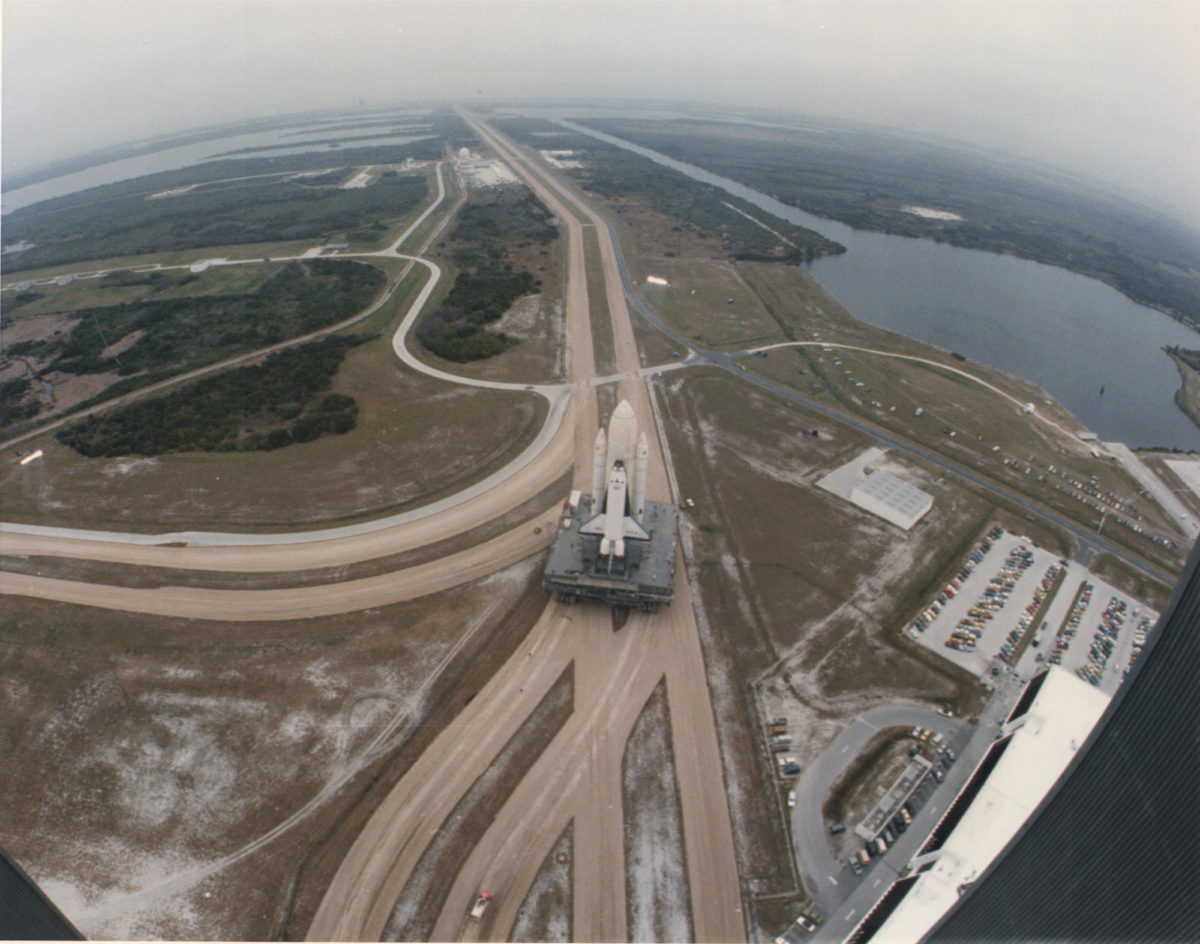
At JPL, Murray pressed for a less-ambitious Halley mission using a direct flyby, going so far as to lobby the White House directly. But with the Reagan administration slashing spending in 1981 to combat the federal budget deficit, NASA found itself in no position to demand a Halley mission. As a result, the United States—the leader in planetary exploration—would not be visiting the world’s most famous comet.
Instead, Russia, Japan and Europe all sent spacecraft on close flybys of the comet in what was referred to as the Halley Armada. Russia passed the comet first, and the honor of the closest approach went to the European Space Agency’s Giotto probe. Giotto made a death-defying plunge through Halley’s tail in March 1986, photographing the comet’s nucleus from just 600 kilometers away. NASA's International Sun/Earth Explorer (ISEE-3) spacecraft, re-purposed as the International Cometary Explorer (ICE), ended up observing Halley from a distance of 28 million kilometers.
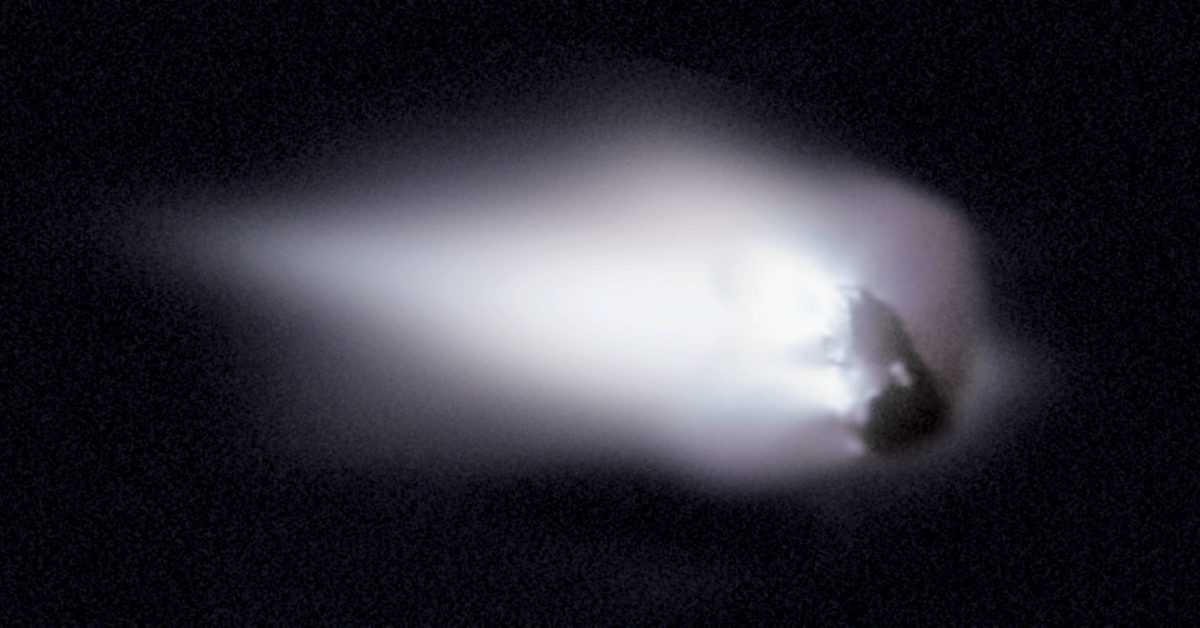
Murray stepped down from the JPL directorship in 1982. Near the height of his crusade to send a spacecraft to Halley, Murray, along with Louis Friedman and Carl Sagan, founded The Planetary Society in 1980. The membership-based, non-profit space advocacy group set out to show policymakers that the public indeed supported planetary exploration. Membership grew, and in 1981, the Society began publishing a magazine called The Planetary Report.
In the inaugural issue, Sagan described the goals of The Planetary Society:
“If we are as successful as at least some experts think we are likely to be, we may be able to accomplish not only our initial goal of demonstrating a base of popular support for planetary exploration; but also to provide some carefully targeted funds for the stimulation of critical activities.”
Those activities would eventually include solar sailing. The quest for flight by light was not over.
The Story of LightSail, Part 2
The second entry in our three-part LightSail history series remembers Cosmos 1, The Planetary Society's first solar sail that launched in 2005 aboard an ill-fated Russian rocket.
The Story of LightSail, Part 3
The final chapter of our three-part LightSail history series details how the loss of Cosmos 1 gives rise to the dream of solar sailing for CubeSats.


 Explore Worlds
Explore Worlds Find Life
Find Life Defend Earth
Defend Earth


